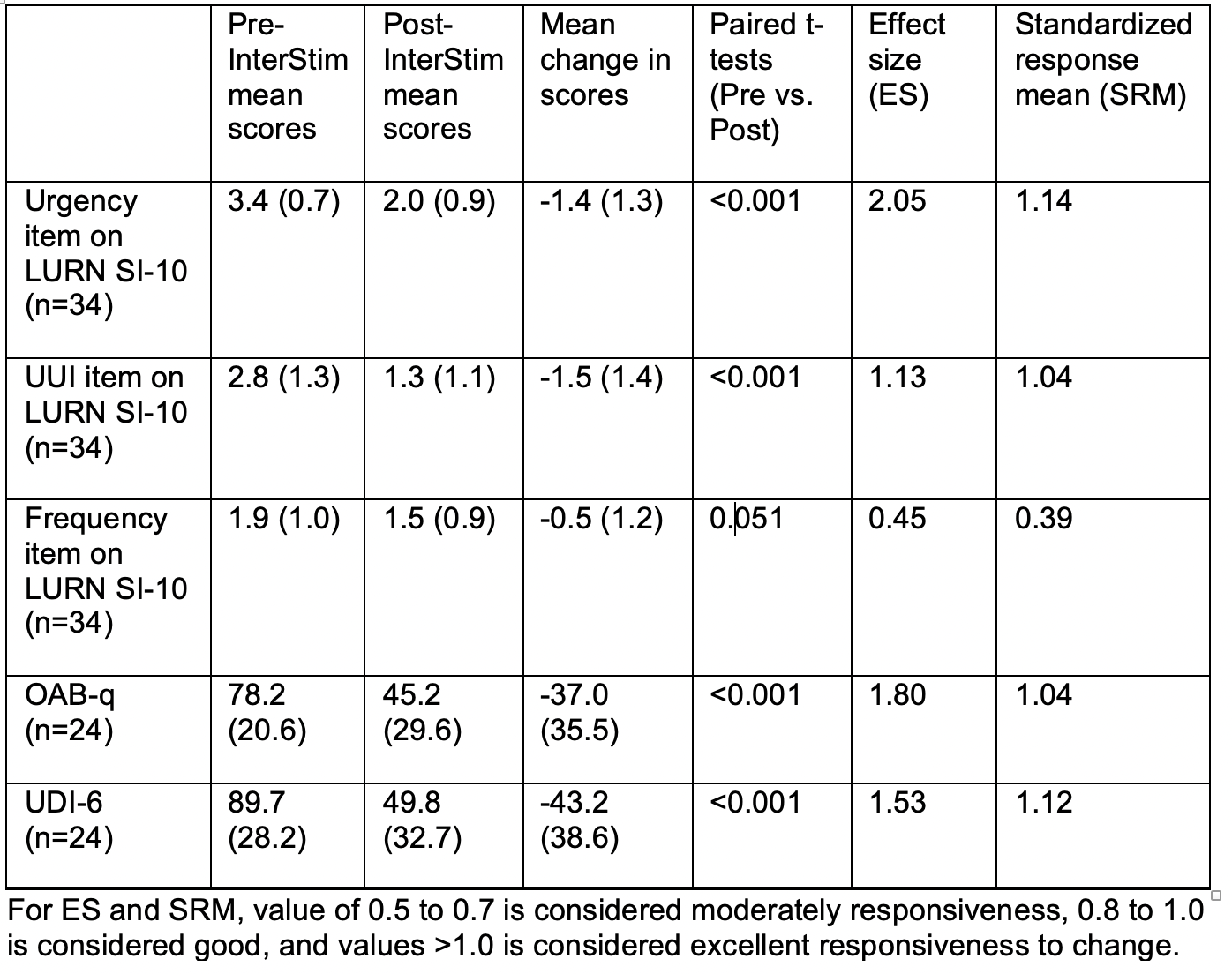Back
Introduction: The LURN SI-10 (10-item LURN Symptom Index) was developed by the Symptoms of Lower Urinary Tract Dysfunction Research Network (LURN) to measure lower urinary tract symptoms LUTS (Cella et al 2019). LURN SI-10 consists of ten items on LUTS, plus an additional question on global urinary bother. Three of the items focus on urinary urgency, urgency urinary incontinence (UUI), and frequency. Here we validate and evaluate the responsiveness of these items on the LURN SI-10 questionnaire by comparing patients’ responses before and after sacral neuromodulation surgery.
Methods: Patients who completed the LURN SI-10, overactive bladder questionnaire (OAB-q), and Urinary Distress Inventory (UDI-6) questionnaires before and after a successful sacral neuromodulation (InterStim) staged trial were included. Indications for InterStim included overactive bladder, UUI, or urinary frequency/urgency. Interstitial cystitis or urinary retention were excluded. Mean change in the urinary urgency, UUI, and frequency scores, paired t-tests, effect sizes (ES) of the change, and standardized response means (SRM) were tabulated. For ES and SRM, value of 0.5 to 0.7 is considered moderate responsiveness, 0.8 to 1.0 is considered good, and values >1.0 is considered excellent responsiveness to change. The LURN SI-10 scores were compared to the OAB-q and UDI-6.
Results: Mean urinary urgency, UUI and frequency scores on LURN SI-10 decreased by 41%, 54% and 26% respectively after sacral neuromodulation (n=34). p-values of paired t-tests were <0.001, <0.001 and 0.051 respectively (see Table). The effect sizes (ES) for the urgency and UUI items were 2.05 and 1.13 respectively, indicating excellent responsiveness to change of the items to known effective treatments. The standardized response means (SRM) for the urgency and UUI items were 1.14 and 1.04 respectively, again indicating excellent responsiveness to change. There were strong correlations between LURN SI-10 scores and OAB-q and UDI-6 (r=0.66 and r=0.70 respectively, all p<0.01).
Conclusions: The urinary urgency and urgency incontinence (UUI) items on LURN SI-10 questionnaire were responsive to change, and may be used to assess overactive bladder symptom change or improvement after sacral neuromodulation surgery. SOURCE OF
Funding: Midwest Stone Institute

Podium Session
Session: PD14: Urodynamics/Lower Urinary Tract Dysfunction/Female Pelvic Medicine: Female Incontinence: Therapy I
PD14-09: VALIDATION OF THE LURN SI-10 QUESTIONNAIRE WITH SACRAL NEUROMODULATION SURGERY
Saturday, April 29, 2023
8:20 AM – 8:30 AM CST
Location: S501A

Henry Henry Lai, MD
Professor of Urology and Anesthesiology
Washington University School of Medicine
Podium Presenter(s)
Introduction: The LURN SI-10 (10-item LURN Symptom Index) was developed by the Symptoms of Lower Urinary Tract Dysfunction Research Network (LURN) to measure lower urinary tract symptoms LUTS (Cella et al 2019). LURN SI-10 consists of ten items on LUTS, plus an additional question on global urinary bother. Three of the items focus on urinary urgency, urgency urinary incontinence (UUI), and frequency. Here we validate and evaluate the responsiveness of these items on the LURN SI-10 questionnaire by comparing patients’ responses before and after sacral neuromodulation surgery.
Methods: Patients who completed the LURN SI-10, overactive bladder questionnaire (OAB-q), and Urinary Distress Inventory (UDI-6) questionnaires before and after a successful sacral neuromodulation (InterStim) staged trial were included. Indications for InterStim included overactive bladder, UUI, or urinary frequency/urgency. Interstitial cystitis or urinary retention were excluded. Mean change in the urinary urgency, UUI, and frequency scores, paired t-tests, effect sizes (ES) of the change, and standardized response means (SRM) were tabulated. For ES and SRM, value of 0.5 to 0.7 is considered moderate responsiveness, 0.8 to 1.0 is considered good, and values >1.0 is considered excellent responsiveness to change. The LURN SI-10 scores were compared to the OAB-q and UDI-6.
Results: Mean urinary urgency, UUI and frequency scores on LURN SI-10 decreased by 41%, 54% and 26% respectively after sacral neuromodulation (n=34). p-values of paired t-tests were <0.001, <0.001 and 0.051 respectively (see Table). The effect sizes (ES) for the urgency and UUI items were 2.05 and 1.13 respectively, indicating excellent responsiveness to change of the items to known effective treatments. The standardized response means (SRM) for the urgency and UUI items were 1.14 and 1.04 respectively, again indicating excellent responsiveness to change. There were strong correlations between LURN SI-10 scores and OAB-q and UDI-6 (r=0.66 and r=0.70 respectively, all p<0.01).
Conclusions: The urinary urgency and urgency incontinence (UUI) items on LURN SI-10 questionnaire were responsive to change, and may be used to assess overactive bladder symptom change or improvement after sacral neuromodulation surgery. SOURCE OF
Funding: Midwest Stone Institute

